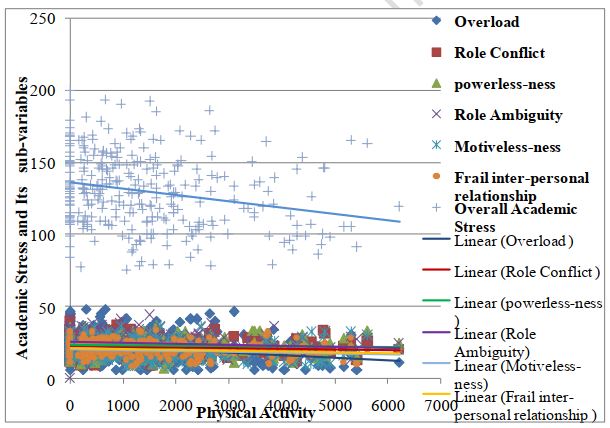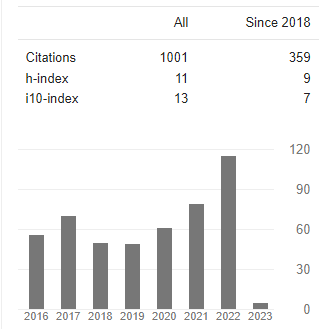ACADEMIC STRESS AMONG SCHOOL TEACHERS IN RELATION TO THEIR PHYSICAL ACTIVITY
Abstract
The present study was designed to examine academic stress among school teachers in relation to their physical activity. A sample of three hundred (N=300)school teachers, out of which one hundred and fifty (n=150) government and one hundred and fifty (n=150) private school teachers of Chandigarh were randomly selected to act as subjects for the present study. Toexamine relationship between academic stress and physical activity among school teachers, theIndore Job Stressors Scale developed byRathod and Varma (2001) and theInternational Physical Activity Questionnaire (IPAQ) constructed by Craig et al. (2003 revised in 2005)were administered to obtain the required information. The relationship of academic stress with of physical activity was evaluated by employing Pearson’s product moment correlation technique. Results of the study revealed that physical activity significantly contributed for the reduction of academic stressamong school teacherswith regard to its sub-variables; overload, role conflict, role ambiguity and overall academic stress. However, insignificant reduction was reported with regard to sub-variable; powerless-ness, motiveless-ness and frail-interpersonal relationship of academic stress with physical activity
Downloads
References
Austin, V., Shah, S., &Muncer, S. (2005). Teacher stress and coping strategies used to reduce stress. Occupational Therapy International, 12, 63-80.
Australian Government Department of Health and Ageing (2013).Physical Activity Guidelines.Retrieved from http://www.health.gov.au/internet/main /publishing.nsf/ Content /health -pubhlth-strategphys-act-guidelines. Retrieved on August 27, 2013.
Buckworth, J., &Dishman, R. K. (2002).Exercise psychology. Champaign, IL: Human Kinetics. Craig, C. L., Marshall, A. L., Sjostrom, M., Bauman, A. E., Booth, M. L, Ainsworth, B.(2003). International Physical Activity Questionnaire (IPAQ): 12-country reliability and validity. Medical Science Exercise Sport, 35, 1381-1395.
Deepshikha B (2016), analysis of job satisfaction among female teachers of secondary school of Meerut, International Journal of Behavoral Social and Movement Science, Vol.05,Jan2016,Issue01, pp20- 28
Garber, M., Jonsdottir, I., Magnus, M., &Ahlborg, G.(2014). Physical activity in employees with differing occupational stress and mental health profiles: A latent profile. Psychology of Sport and Exercise 15(6), 649–65.Retrieved on 1-04-2015 from http://www.sciencedirect .com/science/article/pii/S1469029214001071.
Gillan, W., Naquin, M., Zannis, M.,Bowers, A., Brewer, J. & Russell, S.(2013).Correlations among stress, physical activity and nutrition: School employee health behavior, ICHPER-SD Journal of Research, 8 (1) 55-60.
Hannan, J., Brooten, D., JoAnne M. Youngblut., Hildago, I., Roche, R., &Seagraven, l. (2015). Physical activity and stress in adult Hispanics. Journal of the American Association of Nurse Practitioners, 27(2), pp. 79–86, Feb. 2015.
Howie, L., Lukacs, S., Pastor, P., Reuban, C. &Mendola, P. (2010). Participation in activities outside of school hours in relation to problem behaviour and social skills in middle childhood. J School Health, 80(3),119-125.
Kruse, H.W. (2015). Examining relationship between perceived stress and psychological well-being as moderated by physical activity in college-age participants.Retrieved on April, 2016 from http://scholar.utc.edu/cgi/viewcontent.cgi?article=1319 context=theses.
Mc-Auley, E., Blissmer, B., Marquez, D.X., Jerome, G.J., Kramer, A.F. &Katula, J. (2000).Social relations, physical activity, and well-being in older adults.Prev Med,31(5), 608-617.
McAuley, E., Mihalko, S.L. & Bane, S.M. (1996). Acute exercise and anxiety reduction: Does the environment matter? Journal of Sport and Exercise Psychology, 18, 408–19.
Mental Health Foundation, U.K., (2005). Up and running: Exercise therapy and the treatment of mild or moderate depression in primary care. Retrieved on August 16, 2015 from http://www.mhf.org.uk/publications/?entryid 5=43026.
Rathod, M. B, &Varma, M. (2001).Manual for teachers job stressors scale. Agra. National Psychological Corporation.
S. Bhupinder Singh (2016), A study of psychological variables between male rowing players, Vol.05,April2016, Issue02, pp1-3
Sudhanshu Gupta (2015), Co-branding: a perspective tool to redefine the image of hospitality sector of jammu and kashmir, Vol.04, Oct. 2015, Issue04, pp27-31
Singh Mandeep (2012), Movement technology of an inclusive case through kinematic technology, International Journal of Behavoral Social and Movement Science,Vol.01, Issue01 Jan2012, pp40- 44
Toker, S. &Biron, M. (2012). Job burnout and depression: Unraveling their temporal relationship and considering the role of physical activity. Journal of Applied Psychology, l 97(3), 699-710. doi.org/10.1037/a0026914.
U.S. Department of Health and Human Services (2008).Physical activity guidelines for American.Retrieved on May 21, 2012 from http://www.health.gov/paguidelines /default.aspx.
U.S. Department of Health and Human Services.(2010). Healthy people 2020 public meetings. Retrieved from http://www.healthypeople.gov/ hp2020/.
World Health Organization (2010).Global recommendations on physical activity for health. WHO: Geneva.















